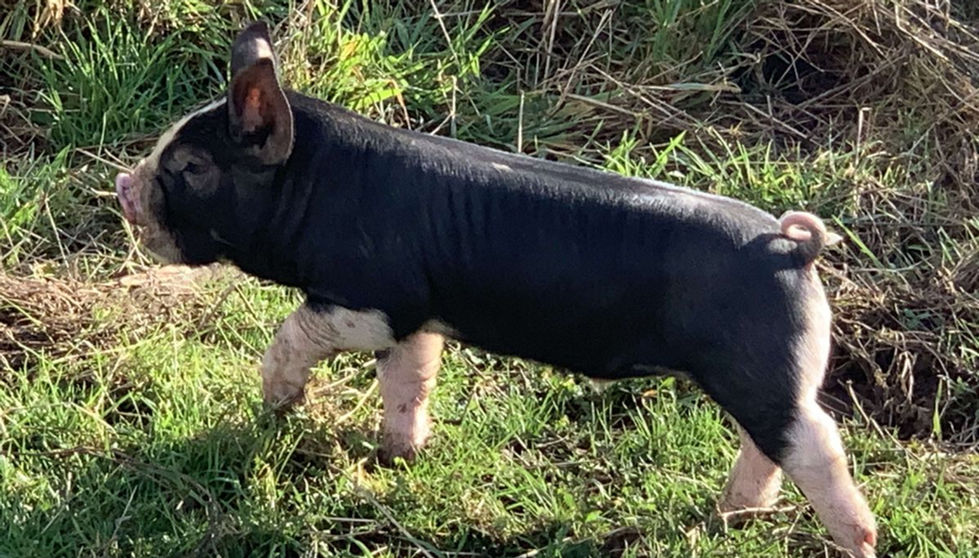
PHOTO COURTESY OF HOLLOW HILL
SOME
HISTORY
The Idaho Pasture Pig, IPP, is a breed that was developed in 2006 and introduced in 2012 by Gary and Shelly Farris. They developed this breed for its good nature, good meat quality, mothering and grazing to have the perfect homestead pig.
In recent years the breed has started to catch the eye of those from other countries as well as the first pigs making it to Hawaii. We are looking forward to continuing to share and spread awareness of this wonderful breed that has captured the hearts of so many across the county and beyond.
CONFORMATION
There are many characteristics that make the IPP such a great pig. It is important as breeders that we only select the pigs that meet the standards to register as breeding stock. It is the hope of the IPPBA that the below information and pictures helps breeders and buyers in making good choices in what should be used as breeding stock and what should be culled and used as a feeder. The IPPBA does not set the breed standard, our goal is that this information will help with the education of breeders and buyers alike.
Please find current breed standards at the Registry website HERE.
DISPOSITION
A very important trait of the IPP is their great disposition and temperament.
-
Generally all IPP's should be friendly, curious, playful, and safe to be around. Human interaction plays a significant part in raising good-natured pigs.
-
Boars should be manageable & not show aggression towards humans.
-
Feeders & Breeders raised with human interaction should be worked with at times other than feeding to deter association of humans & food. Creates desire for affection rather than purely a food provider.
-
Sows should have a mothering instinct to protect her piglets, but should allow humans to interact. Caution should be taken when working with piglets while in the sow's pen.
-
An aggressive pig should be culled and does not meet breed standard for disposition.
HEAD CONFORMATION
BREED STANDARD
IPP's should have a short to medium length snout with an upturn to encourage grazing and reduce rooting. The snout should not be long, straight, or taper down to a small nose. The snout should not be narrow and should have a width that compliments the shape of the head.
The snout should not be long, straight, or taper down to a small nose. The snout should not be narrow and should have a width that compliments the shape of the head.
NOT BREED STANDARD
EARS, EYES, & WATTLES









EYES
Should be set well apart and facing forward, not squinted which could hamper their vision.
WATTLES
All variations of wattles are acceptable, many prefer two wattles over one.
EARS
Ears are preferred erect, but ears that droop are acceptable.
BACK, TOP LINE, BOTTOM LINE
Photos above provide visual aid in determining the traits desired for breeder quality reproduction. The pig should show straight skeletal structure from shoulders through the rump on the topline, as well as a smooth bottom line with out bulges growths & sways.
This section of the topline offers photos depicting traits that should not be carried on whether genetic or environmental.
If a pig carries its back high or low that is cause for concern in breeding quality
as it may lead to a sow unfit to properly carry or birth piglets.
A boar showing these signs may not be able to sufficiently service sows/gilts.
UNDERLINE & TEAT STRUCTURE
When observing a pigs underline some of the most important observations that need to be made are....
-
Quantity of Teats
-
Does he/she have 10 or more?
-
-
Quality of Teats
-
Are they evenly spaced?
-
Are they to close together?
-
Are they useable?
-
Inverted (not useable)
-
On the inner thigh (not useable)
-
Very close together (one of the teats is usually not useable)
-
-
-
Male teats should also follow these guidelines when breeder quality is desired.
SHOULDERS, HAMS, LEGS
HAMS
Hams should be well rounded the 3 photos to the right show well rounded rumps. Desired is also a high tail set. Hips should sit straight up from the feet.
LEGS
Legs should be broad, & set straight down to feet. Toes should point forward not in or out. In the lower leg the pasterns should not touch the ground or be stiff.
The first photo to the right shows a slight bend from top of the pastern to the toes to give spring to the step.
SHOULDERS
To the right you will notice a female shoulder compared to a mature boar shoulder.
Note the Shield on the boar in the middle photo.
Shoulders should set directly above the feet.








COLORS OF THE IPP

IPP'S come in many colors.
Registerable colors are Black, Ginger, Cream, Brown/White, White/Black, Ginger/Black, Tri-Colored (White/Ginger/Black)
Below you can click on the photo to see a visual of the colors.








MEAT QUALITY
IPP meat is not your "other white meat" that you get at the grocery store.
You can see from these pictures it is a nice dark red meat with good marbling
and it is packed with flavor!


















